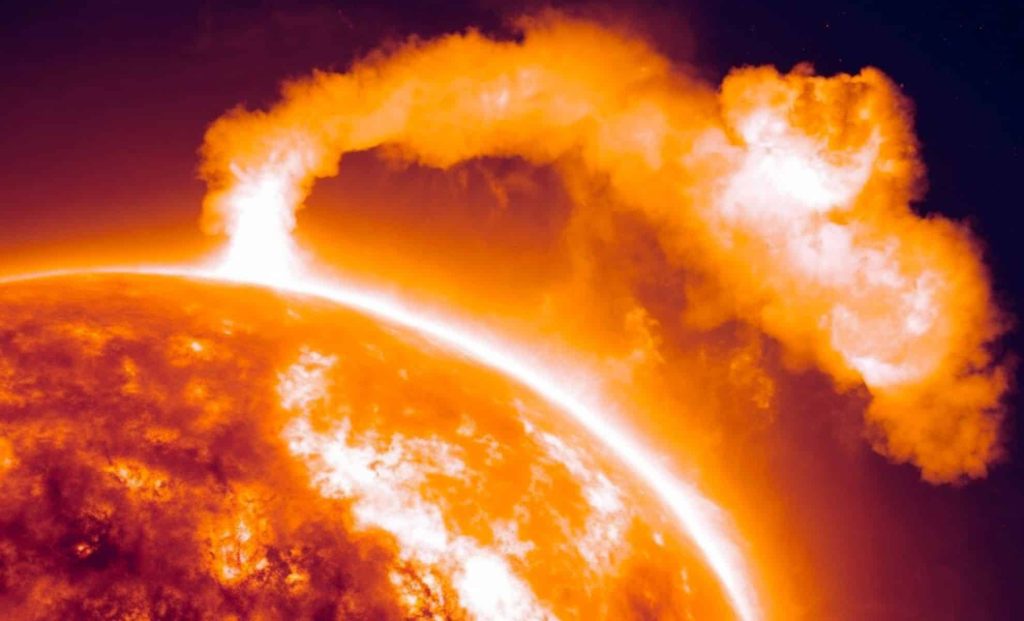Next Solar Superstorm Might Leave the Planet in Darkness: Experts Sound the Alarm – The Daily Galaxy –Great Discoveries Channel

A massive solar storm could be brewing, with the potential to wreak havoc on Earth’s power grids, satellites, and communication systems. While the skies light up in stunning displays, the unseen danger is far more chilling. The increasing interconnectedness of modern technology amplifies the dangers posed by solar storms. Global economies rely on real-time communication networks, financial systems, and logistics chains that span continents. A single failure in one region can cascade across the globe. For instance, a blackout in the United States could disrupt global internet traffic, interfere with international banking, and delay essential shipments, from medical supplies to food.Moreover, countries with aging infrastructure, such as certain regions in Europe and Asia, are particularly vulnerable. These systems often lack modern safeguards to withstand geomagnetic currents, making them susceptible to widespread and prolonged damage.Power grids are often described as the backbone of modern life, but they are also highly vulnerable to geomagnetic storms. The long wires in these networks act as conduits for geomagnetic currents induced by solar activity. Transformers, critical components of these grids, can overheat and fail under the strain.Replacing a single transformer can take weeks, but a large-scale event might damage thousands of them at once. The production backlog and logistics challenges involved in replacing these transformers could extend recovery times to months—or even years.Despite these risks, many power companies prioritize cost-efficiency over resilience, leaving their infrastructure exposed. A large-scale solar storm could plunge millions into darkness, disrupt water supplies that depend on electric pumps, and halt transportation systems dependent on electricity.Satellites are crucial to modern life, enabling everything from GPS navigation to international financial transactions. Yet, they are among the most vulnerable systems during a solar storm. High-energy particles from solar flares can disable satellite electronics, distort signals, or even knock satellites out of orbit.The Starlink incident of 2022 demonstrated this risk. A geomagnetic storm caused atmospheric drag that burned up 40 newly launched satellites. For global navigation, weather forecasting, and internet services that depend on satellite networks, such events could result in widespread outages.Additionally, satellite-dependent industries, such as aviation and maritime transport, could face delays and safety risks. Aircraft often use satellite navigation and communication, and disruptions could complicate flight planning or even lead to grounding fleets.The Carrington Event of 1859 offers a stark reminder of what a massive solar storm can do. During that event, telegraph operators reported sparks flying from their equipment, with some devices catching fire. Yet, the technology of that era was rudimentary compared to today’s interconnected systems.More recently, the Quebec blackout of 1989 showcased the destructive potential of even moderate solar storms. A geomagnetic storm caused a complete failure of Quebec’s power grid, leaving millions without electricity for over nine hours. The incident served as a wake-up call but resulted in limited global action to reinforce infrastructure.Organizations such as NASA, NOAA, and the European Space Agency (ESA) are working to monitor solar activity and predict geomagnetic storms. Their efforts include deploying advanced spacecraft like the Solar and Heliospheric Observatory (SOHO) and the Parker Solar Probe, which provide early warnings of solar activity.However, early detection is only part of the solution. Effective mitigation requires pre-established protocols and cooperation across borders. Some experts advocate for the creation of an international body dedicated to geomagnetic storm preparedness, akin to the World Health Organization (WHO) for public health crises.As solar activity intensifies during the current solar cycle, the risks of a geomagnetic storm grow more pronounced. With global reliance on advanced technology increasing, the consequences of inaction could be devastating.The challenge is clear: the world must invest in robust protective measures to safeguard its critical systems. Whether through upgrading power grids, developing resilient satellite systems, or fostering international cooperation, the time to act is now.The Sun’s behavior may be unpredictable, but our response doesn’t have to be. Preparing for the next solar storm is not just about averting disaster; it’s about ensuring the resilience of a world built on technology.This article came from a press release in the River Reporter.Got a reaction? Share your thoughts in the commentsEnjoyed this article? Subscribe to our free newsletter for engaging stories, exclusive content, and the latest news.The 1,500 reactors’ll explode in case of an unprevented long blackout/war/chaos – ‘shelters’ are useless. BUT there’s a laser-plasma solution!
https://GlobalBlackoutPrevention.wordpress.comSeems like I should work for these people cuz they need me; I been saying this for about a year now. Glad y’all are finally caught up. Same with the auroras; yea let’s NOT go outside to look at the pretty radiation!Comment Save my name, email, and website in this browser for the next time I comment.
© 2024 | Daily Galaxy | All rights reserved






